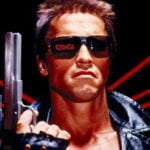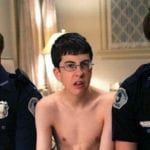 Technology
Technology  Technology
Technology  Humans
Humans 10 Everyday Human Behaviors That Are Actually Survival Instincts
 Animals
Animals 10 Animals That Humiliated and Harmed Historical Leaders
 History
History 10 Most Influential Protests in Modern History
 Creepy
Creepy 10 More Representations of Death from Myth, Legend, and Folktale
 Technology
Technology 10 Scientific Breakthroughs of 2025 That’ll Change Everything
 Our World
Our World 10 Ways Icelandic Culture Makes Other Countries Look Boring
 Misconceptions
Misconceptions 10 Common Misconceptions About the Victorian Era
 Mysteries
Mysteries 10 Strange Unexplained Mysteries of 2025
 Miscellaneous
Miscellaneous 10 of History’s Most Bell-Ringing Finishing Moves
 Technology
Technology Top 10 Everyday Tech Buzzwords That Hide a Darker Past
 Humans
Humans 10 Everyday Human Behaviors That Are Actually Survival Instincts
 Animals
Animals 10 Animals That Humiliated and Harmed Historical Leaders
Who's Behind Listverse?

Jamie Frater
Head Editor
Jamie founded Listverse due to an insatiable desire to share fascinating, obscure, and bizarre facts. He has been a guest speaker on numerous national radio and television stations and is a five time published author.
More About Us History
History 10 Most Influential Protests in Modern History
 Creepy
Creepy 10 More Representations of Death from Myth, Legend, and Folktale
 Technology
Technology 10 Scientific Breakthroughs of 2025 That’ll Change Everything
 Our World
Our World 10 Ways Icelandic Culture Makes Other Countries Look Boring
 Misconceptions
Misconceptions 10 Common Misconceptions About the Victorian Era
 Mysteries
Mysteries 10 Strange Unexplained Mysteries of 2025
 Miscellaneous
Miscellaneous 10 of History’s Most Bell-Ringing Finishing Moves
Top 10 Movies Of 2001
Per the unofficial “20 years later” nostalgia cycle, 2001 is scheduled for a resurgence. Before long, we’ll all be pining for flip phones and the Yahoo! search engine.
A few weeks ago we looked at some of the best albums from that year. We now turn our attention to the cinema with a mix of superior dramas, action and animated films. Here are ten of 2001’s top movies.
Top 10 Albums That Launched the 2000s
10 Memento
The disorienting film about a man with anterograde amnesia got everything backwards – including its release. Despite being an American-made move, Memento initially debuted with a limited run in Europe (including the Venice Film Festival) in 2000 before its wider release in March 2001. The AMPAS officially counts it as a 2001 release, evidenced by its Oscar nomination for Best Screenplay.
Memento’s memorability comes in its uniquely erratic use of time. The protagonist, Leonard, has been brutally assaulted, and his wife murdered. He’s killed one of the attackers, and is struggling to recall the other assailment because of his wound-inflicted inability to remember anything for more than a few moments. After that, he’s a blank slate back at square one.
As Leonard becomes aware of his condition, he begins leaving his future amnesiac self clues – mementos – to help him move the investigation forward. He jots notes, snaps Polaroids and even gets a tattoo of the at-large attacker’s license plate. He eventually finds – and kills – his man (or does he?), only to learn he’s been manipulated by a supposed friend into doing his dirty work. Leonard then kills this alleged friend, Teddy, in a scene the audience realizes was depicted in an opening-scene Polaroid. Confused yet?
Filmmaker Christopher Nolan uses a clever tactic to help audiences distinguish which way time is running: the color sequences move backward while the black-and-white scenes go forward. This explains why colorblind people, including me, were so damn lost throughout.
9 Black Hawk Down
Released in December 2001, Ridley Scott’s movie about a failed US military operation from eight years earlier seemed suddenly timely in the wake of the 9/11 terror attacks. Depicting the fog of war in a mission gone horrifically sideways – a purposefully dizzying effect that earned an Academy Award for Best Editing – Black Hawk Down gave moviegoers a harrowing look at warfare just weeks after the US invasion of Afghanistan began.
In hindsight, Black Hawk Down serves as warning about the limits of military might in far-flung third-world nations. The film chronicles an attempted raid to capture a Somali militia leader holed up in the country’s sprawling, decrepit capital of Mogadishu. All goes according to plan initially, as the raiding party apprehends two of the leader’s top aides. Soon, though, chaos ensues as two Black Hawk helicopters are shot down by rocket-propelled grenades.
The US soldiers – an ensemble cast with no true main character, which works well in such a mad-scramble film – reroute to rescue the crash survivors, only to end up pinned down and short on ammo. The planned 90-minute incursion turned into 17 hours of bloody battle, during which 19 US soldiers were killed.
Black Hawk Down draws parallels to another 2001 release: HBO’s acclaimed World War II miniseries, Band of Brothers, which follows the adventures of Easy Company from D-Day through the fall of Berlin. Both showcase war at its grittiest and most hellish while emphasizing the soldiers’ dedication to their duty and each other.
8 Ocean’s Eleven
The atrocious sequels it birthed belie the fact that Ocean’s Eleven, the 1960 Steven Soderbergh remake of the same-named 1960 Rat Pack classic, is among the most entertaining heist movies ever.
Remaking a movie – especially one that originally starred Frank Sinatra, Dean Martin and Sammy Davis, Jr. – is risky business. One of the reason’s Ocean’s Eleven pulls it off swimmingly is four decades of technology; not in moviemaking, but in casino security. The film’s simple yet compelling premise begs the question: “How can a group of thieves circumvent the Front Knox-esque security protocols of a modern Las Vegas casino?”
The result is a Mission: Impossible-type film, minus Tom Cruise’s blazing guns and general unlikability. The tension is cut by exemplary performances by the ensemble cast: George Clooney at his most arrogant; Matt Damon at his most awkward and aloof; Brad Pitt at his smarmiest (Damon: “Are you suicidal?” Pitt: “Only in the morning.”).
As Don Cheadle attempts to cripple the Strip’s power grid, Bernie Mac feints at racial injustice to distract the casino owner (Andy Garcia), and a diminutive, non-English-speaking Asian man stows away in a safe to gain access to the vault, there is just enough of each intentionally uncomplicated character to keep the audience engaged rather than annoyed. Fittingly, both the casino manager and audience are thrown a deep fake before learning how the gang of antiheroes robs the Bellagio blind.
7 61*
Most sports movies are comedies, so it’s ironic that one of the most dramatic ever made was directed… by a comedian.
The Billy Crystal-directed 61* recalls the 1961 baseball season in which two New York Yankees – Roger Maris and Mickey Mantle – threatened Babe Ruth’s single-season home run record of 60. While Mantle was an already-legendary Yankee great, Maris was a comparable also-ran and, when it becomes clear that Maris alone has a chance to break the immortal Ruth’s mark, both media and fans turn against him.
The film is more than sports theater: it’s an exercise in pressure. As the six-month season plays out, the introverted Maris is placed under such stress that his hair falls out in clumps, and he tries to convince manager Ralph Houk to bench him to preserve Ruth’s mark. Hauk refuses and, on the season’s final day, Maris smashes the record-setting 61st homer.
In 2001, 61* was timely not for its 61 but for its *. When Maris broke the record, the baseball season had recently been expanded by eight games. For that reason, an asterisk was placed on Maris’ record to signify the benefit of a slightly longer season.
By 2001, however, that asterisk meant something entirely different: steroids. In 1998, TWO players – Sammy Sosa and Mark Maguire – broke Maris’ mark, the latter hitting an ungodly 70 homers. Then in 2001, Barry Bonds hit a ridiculous 73. All three have been linked to performance-enhancing drugs, and purists still consider Maris the single-season home run champion.
6 Monsters, Inc.
Along with the original Shrek, Monsters, Inc. was one of two outstanding animated movies released in 2001. The kids-friendly Pixar film featured a star-studded cast of voiceover actors, including Billy Crystal, John Goodman, Steve Buscemi, James Coburn and Jennifer Tilly.
The plot is simple yet purposeful. The city of Monstropoiis is powered by children’s screams, and energy becomes short in supply when kids don’t scare as easily as they used to. So the city sends its top “scarers,” including the films two protagonists, to rectify the situation. Hijinks ensure, with lighthearted comedy underpinning the overall message: that monsters aren’t so frightening after all.
In his review for Salon, Charles Taylor summed up the success of Monsters, Inc. and, indeed, any worthwhile movie targeted chiefly to children. He called the effort “agreeable and often funny, and adults who take their kids to see it might be surprised to find themselves having a pretty good time.” Monsters, Inc. pulls off what the best animated films (like Aladin) or kid-centric franchises (like Harry Potter) do: it transcends generational divides to appeal to audiences of all ages.
Monsters, Inc. received widespread critical acclaim, and holds a 96% critics’ approval rating on Rotten Tomatoes. It cleaned up at the box office, generating nearly $600 million worldwide to become the year’s third highest-grossing film.
5 Training Day
Training Day is proof positive that an outstanding acting performance can turn a ho-hum script into a critically acclaimed box office success. If you’ve ever wondered why legends like Denzel Washington routinely pull in $30 million a movie… well, you’ve never seen Training Day.
The plot is both thin and repetitive. Washington plays Los Angeles police detective Alonzo Harris, whose narcotics beat provides ample opportunities to be dirty. The “cop on the take” motif is a gritter yet still-hackneyed 80s movie knockoff, a point exacerbated when the story goes… pretty much nowhere.
Assigned to mentor a new officer (Ethan Hawke), Washington commits progressively egregious offenses as the movie somehow achieves a two-hour run time from a 20-minute story. Cameos by Dr. Dre and Snoop Dogg further distract the audience from realizing nothing much is happening here besides a protracted game of bad-cop/worse-cop.
So why the hell is Training Day on this list? Simple: it’s arguably the most amazing performance of Washington’s storied career. In other marquee performances – Philadelphia, American Gangster, Malcolm X – Washington had the benefit of an enticing plot. Not so with Training Day, where extracting him from the film would leave an unmitigated disaster. Training Day is worth watching to witness a brilliant actor single-handedly salvage a subpar film into an eminently enjoyable one.
The Academy agreed: Washington took Best Actor honors, and earned Ethan Hawke a Best Supporting Actor nomination simply by sharing the screen with him.
4 Murder on a Sunday Morning
Long before “Making a Murderer,” the Netflix documentary series depicting two Wisconsin men who vehemently claim they were falsely convicted of murder, there was 2001’s “Murder on a Sunday Morning”. The film chronicles the case of Brenton Butler, a 15-year-old from Jacksonville, Florida accused of shooting and killing tourist Mary Ann Stephens in 2000.
The case bears a striking resemblance to “Making a Murderer.” First and foremost, both documentaries showcase minors – Butler, 15 and Brendan Dassey, 16 – who admitted to the crimes then recanted their confessions. Both confessions have complicating circumstances: Dassey has an IQ of just 70 – which is borderline mental retardation. Butler’s situation feels particularly current: He’s black, and claimed his confession came amid police intimidation and physical abuse.
As explored in the documentary, the investigation and prosecution of Butler was forced and sloppy even if his claims of being beaten were unprovable. Butler was significantly shorter and younger than the victim’s husband, who was present at the murder, recalled, and Butler’s questioning and confession took place over 13 hours during which his parents weren’t notified (in fact, they’d filed a missing person’s report).
The jury took all of 45 minutes to acquit Butler. In 2004, an anonymous tip led police to the real killer, Juan Curtis, who was tried and convicted after a reexamination of Stephens’ purse found his fingerprints. The film won an Academy Award for Best Feature Documentary.
3 The Royal Tenenbaums
Arguably the most egregious Oscar snub of 2001 was that The Royal Tenenbaums wasn’t nominated for Best Picture, nor Wes Anderson for Best Director. The 2001 dramedy shows Anderson refining his now-trademark symmetry, camera angles and distinctive narrative style in a way only hinted at in his previous effort, 1998’s Rushmore.
There is so much to like that it’s difficult to begin dissecting. For starters, Anderson’s use of narrative cutaways to provide eccentric, comedic backstories to a cast of uniquely flawed characters serves to endear each to the audience and keep any one from truly emerging as a main character. The result is an ensemble cast of low-grade heroes and antiheroes that the audience roots for simultaneously, despite knowing their conflicting motives and goals make each character’s success an impossibility.
And what a cast it is. Luke Wilson as a washed-up pro tennis player in love with his adopted sister (Gwyneth Paltrow), a mousy-yet-promiscuous closet smoker with a missing finger. Owen Wilson as a drug-addicted, hack novelist family friend. Ben Stiller as a paranoid widower who loathes his father, Royal (Gene Hackman).
Another outstanding feature is Anderson’s ability to change tones on a dime. Scenes featuring Royal shoplifting with his young grandsons and Danny Glover falling into a construction-site hole fold into Luke Wilson’s semi-incestuous romantic yearning and eventual suicide attempt. The soundtrack helps the audience keep pace, with upbeat punk songs from the Ramones and depressing strums from Elliott Smith bookending emotional extremes.
2 The Fellowship of the Ring
The first installment of Peter Jackson’s Lord of the Rings trilogy was a welcome rarity: a big-budget blockbuster that did justice to an epic series of novels. Exemplified by its December release date, the film had Oscar intentions rather than summer smash money-grab – and it delivered like few fantasy movies do.
Filmed in Jackson’s native New Zealand, a fitting backdrop for J.R.R. Tolkien’s Middle Earth, The Fellowship of the Ring is an even greater accomplishment when extenuating circumstances are considered. First is the density of Tolkien’s novels, essentially mandating that each film be an intimidating three hours long. The other challenge is the subject matter; simply put, it’s really easy to make hobbits, dwarves, elves and wizards seem extraordinarily cheesy.
Fantasy book adaptations are exceedingly tricky to pull off (SEE: Dr. Moreau, The Island of), and at first glance the effort seems to big NOT to fail. Instead, it excels with a mix of convincing landscapes, proper pacing and special effects that complement rather than overwhelm.
The Fellowship of the Ring was nominated for an incredible 13 Academy Awards, including Best Picture and Best Director, and took home four trophies for Best Cinematography, Best Visual Effects, Best Makeup and Best Original Score. Per Rotten Tomatoes, more than 200 critical reviews give the film an average score of an impressive 91%, with 95% of moviegoers giving the thumbs up.
1 A Beautiful Mind
It’s likely Jackson would have won Best Director, and “The Fellowship” Best Picture, were it not for a riveting film about… a Princeton University mathematician?
Also released in December 2001, A Beautiful Mind was a Ron Howard-directed film adaptation of a 1997 biography from author Sylvia Nasar. It chronicled the promising-turned-tragic life of John Nash (Russell Crowe). A math genius on par with Good Willing Hunting’s Matt Damon, Crowe’s early academic achievements included a novel approach to governing dynamics and, a few years later, cracking encrypted enemy messages for the Pentagon.
Sadly, Nash’s brilliance is turned on its head by… well, his head. He develops paranoid schizophrenia, and begins using his code-cracking knack to obsessively search newspapers and magazines for hidden Soviet messages. It is this dark turn where A Beautiful Mind earns its critical acclaim. As Nash’s brain is slowly overwhelmed, the audience is invited into his delusions, at first thinking they are real because, as is the case with many progressive mental maladies, its first signs were relatively believable.
The biopic’s happy ending mimics Nash’s own: eventually, he learns to outsmart his delusions, a sort of heroic mind-over-non-matter. By the late 1970s, Nash was once again a respected professor and, in 1994, won a Nobel Prize for his revolutionary work on game theory – which, incredibly considering his schizophrenia, is the practice of predicting strategic interactions between rational decision-makers.
Top 10 Defining Moments of the 2000s








